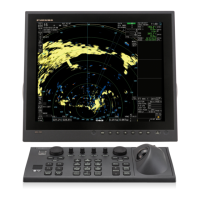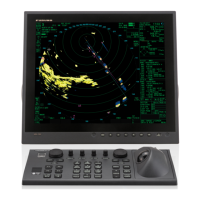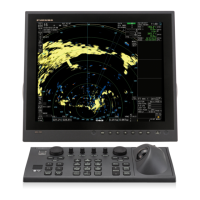Do you have a question about the Furuno FAR-2228-NXT-BB and is the answer not in the manual?
General notices regarding manual usage, copying, and potential changes to equipment specifications.
Guidance on proper disposal of the product and used batteries according to local regulations.
Explains DANGER, WARNING, CAUTION signals and general safety precautions for equipment operation.
Details hazards of RF energy from the radar antenna and safe operating distances.
Information on warning labels attached to the equipment and the importance of not removing them.
Welcome message, FURUNO's reputation, product features, models, and configurations.
Defines manual terminology, provides software URLs, and lists radar types and abbreviations.
Details system configurations for X-band and S-band radars, including connected units and component categories.
Provides notes on unit categories, installation, and specific configuration considerations.
Detailed description of controls on RCU-014 and RCU-015/016 units for radar operation.
Instructions for turning the radar on/off, adjusting brilliance, and understanding display indications.
Guides on operating menus, on-screen boxes, and cursor functions for interaction.
Explains how to assign functions to keys, customize operation, and manage user settings.
Procedures for setting heading input, own ship speed, own ship position, and adjusting date/time.
Covers receiver tuning, pulselength selection, sensitivity, clutter reduction, and interference rejection.
Details on preset controls for navigation, customized echoes, second-trace echoes, and orientation modes.
Procedures for selecting range scales, measuring range/bearing, using EBLs, VRMs, and target trails.
How to use various marks, manage trails, handle SD cards, take screenshots, and use watch alerts.
Information on interswitch settings, dual radar operation, wave mode, Doppler feature, and performance monitoring.
Defines minimum/maximum range, radar resolution, bearing accuracy, and false echoes.
Explains SART operation, RACON signals, radar target enhancers, and solid-state radar characteristics.
Safety warnings, cautions, and overview of TT controls and box indications.
Procedures for acquiring, tracking, canceling targets, setting own ship speed, and handling lost targets.
Customizing TT symbols, managing system messages, performing trial maneuvers, and setting tracking criteria.
Explains AIS transponder connection, controls, box overview, and display modes.
How to filter AIS objects, activate/sleep targets, set auto-activate functions, and manage AIS data.
Inputting voyage data and displaying basic/expanded AIS data.
Lists and explains AIS system messages, their priority, and meanings.
Explains orientation modes and how to select and inscribe marks on the display.
How to show/hide radar map marks, select mark colors, delete marks, and manage own ship/target tracks.
Procedures for using waypoints, setting data sources, entering, erasing, and displaying waypoint lists and routes.
How to show/hide charts, align chart position, select chart types, and configure chart settings.
Schedule for regular maintenance checks and procedures for replacing fuses.
Estimated life expectancy of parts and common troubleshooting steps for operational issues.
Procedures for diagnosing hardware/software issues and running system diagnostic tests.
Explains system fallback mechanisms for sensor failures and their limitations.
| IMO Compliance | Yes |
|---|---|
| Frequency | 9410 MHz ± 30 MHz |
| Range Scales | 96 nm |
| Transmitter Power | 25 kW |
| Rotation Speed | 24 rpm |











